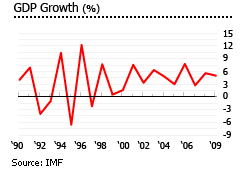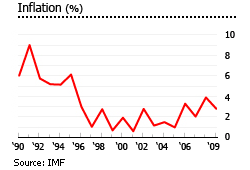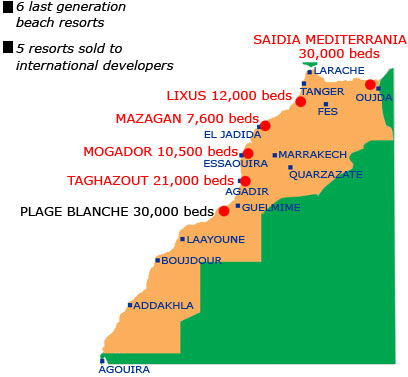Morocco goes all-out to push housing market growth
Morocco’s government is going all out to pump-prime its housing market. The Moroccan housing market was somewhat weakened by local and global crises in 2007 and 2008, and the government is trying to lure Moroccans living abroad to buy properties in the country, by offering 25-year 100% loans up to US$100,000.
Unlike most countries in the Middle East, Morocco has long encouraged foreigners to purchase and invest in property in the Kingdom. Foreign citizens can freely buy, rent and invest in land and real estate in Morocco (except agricultural land).
Central to the government’s plan of boosting real estate and tourism investment is Vision 2010, the ambitious plan laid down in 2001 by Morocco's King Mohammed VI, aimed to increase tourist arrivals to around 10 million.
Despite the global economic slowdown, the government has continued to increase spending for the construction and renovation of roads, airports, and seaports. Work began in April 2009 on a new high-speed railway connecting the key cities of Tangier and Casablanca. It is expected to be completed in 2016.
The increase in government spending combined with good harvests since 2008 has helped the Moroccan economy grow at impressive rates, despite the global crisis. After 2.7% growth in 2007, the economy grew at an impressive 5.6% in 2008. GDP is believed to have risen 5% in 2009, and the IMF forecasts 3.2% growth in 2010.
Global Property Guide figures show that prices of Marrakech riads continue to mount. This year saw riads prices definitively breach the US$3,000 per square metre barrier for all riad sizes, with the very smallest riad size-category reaching US$4,000 per square metre.
Economic reform

Morocco’s economy has been doing well. King Mohammed VI, who succeeded in 1999, is a dynamic monarch who has brought substantial reform to Morocco, and some national reconciliation following the torture which marked the early years of his father’s rule.
Although GDP growth has been a little erratic, the economy never contracted under his term. Economic growth was particularly strong in 2001 (7.6%), 2003 (6.3%) and 2006 (7.8%). The last time the economy contracted was in 1997 (-2.2%).
Morocco’s sustained economic growth has led to a drop in unemployment, from 11.4% in 2003, to 9.6% in 2008. In urban areas, the unemployment decline during this period was more pronounced, from 19.3% to 14.7%. In Q2 2009, unemployment was at its lowest level yet, at 8%, before rising to 9.8% in Q3.
Inflation management has greatly improved, with the inflation rate averaging 1.38% during the period of 1999 – 2005, down from 6.2% from 1990 to 1995.
In mid-February 2007, a study called "Arab Reform and Foreign Aid: Lessons from Morocco” concluded that Morocco provides a valuable lesson in political and economic reform – that top-down reforms can be highly effective, if skillfully and determinedly carried out, and that aid donors should lean towards countries where evidence of such commitment is to be found. The study was published by the Center for Strategic and International Studies based in Georgetown University.
Higher public spending for 2010

Public works spending is projected to grow by 20% in 2010, while state investment is expected to rise by a similar percentage. Projects funded by this increase in spending include the expansion of Jorf Lasfar power station, wind farms in Tangier and Tarfaya, and other power-generation plants.
However, the increase in spending will lead to a budget deficit, after surpluses in 2007 and 2008. The budget deficit is expected to be around 2.7% in 2009, rising further to 4% in 2010.
The government is forecasting inflation of around 2.8% in 2009 and 2010, down from 3.9% in 2008.
Planned tourism explosion

The massive tourist/residential development program, Vision 2010 – of which the coastal part has come to be known as ‘Plan Azur’ – aims to bring 10 million visitors a year to Morocco by 2010 and build 6 new coastal resorts, 250,000 hotel beds, including 180,000 located in or around the cities.
By promoting an “open skies” policy, the government is targeting around 1,300 weekly flights into Morocco, with 15.6 million passengers per year. In 2008, almost 8 million tourists visited Morocco. Tourists arrivals are expected to increase by 5% in 2009, to 8.4 million. The authorities are confident that the target of 10 million tourists for 2010 can easily be attained, especially with the gradual recovery of the global economy.
Tourism almost invariably brings increased interest in property buying, and will likely have a large impact both on Morocco’s economy, and on property prices.
New coastal resorts included in Plan Azur:

Source: 7th International Tourist Conference handbook, Fes 2007
Outside the mass market
The long Moroccan real estate boom, of course predates the mass market, and concentrates on the ‘authentic’ Morocco – and above all on giving Westerners a stylish life in exotic, traditional surroundings.
At its core has been the craze for buying Riads. It is not unusual to see Riads – traditionally-shaped Moroccan houses, with grand salons giving onto a central tiled courtyard, often with a garden at the center - offered on the Web for €500,000 or in the case of the most palatial, €1,000,000. Around 7,500 - 15,000 French residents live around Marrakech in these and other accommodations.
Will Morocco run out of Riads? “Oh no, there are 50,000 Riads in Marraketch and only 1,000 are sold to foreigners,” says Charles El Fassy of the real estate agent Cabinet Charles El Fassy. The coasts are also a major destination for French and other European tourists and those looking for a second home.
Social housing
With property developers mainly focused on tourist-oriented properties, the government has initiated programmes to increase the supply of affordable houses (priced below MAD140,000 or US$18,205). In July 2009, the government signed an agreement with industrialists working in the sector, aimed at encouraging property developers to engage in these projects, and to house up to 800,000 people.
Stable rental yields
Gross rental yields in Morocco this year are almost unchanged from previous years. Yields are generally rather acceptable. In Casablanca, yields range from 6.4% to 9.2% for apartments, but are much lower (as might be expected) for houses, at 4.6%.
In Marrakech, as in all previous years, we were unable to get enough data to offer numbers for yields on riads. However, apartments in Marrakech offer acceptable yields at between 6.2% and 7.6%.
The attraction centres of Morocco
The cultural and physical attractions of Morocco centre on its traditional cities – Marrakech, Fes, Meknes, Casablanca, and Essaouira – and on its one coastal resort, Agadir.
Marrakech
Marrakech was built in 1070 A.D.. It is famous for its palaces, open markets, and gardens. It is an extraordinarily exotic city, with its drama heightened by a location at the foot of the Atlas Mountains.
Marrakech is expecting three and half million tourists by 2010. Marrakech has a complete tourism zone, Aguedal. A public transport system carries tourists from the district into the city centre for its souks and traditional markets selling copperware, wool merchandise, and carpets and kaftans. There are no less than 27 5-star hotels in Marrakech.
Fes
For over 400 years, Fes was the capital of Morocco. Founded in 789 A.D, it is the world’s oldest medieval city, and the largest. Considered Morocco’s intellectual and religious capital, it is a UNESCO world heritage site.
It was at the peak in the 14th century, and saw a fresh burst of glory in the 17th century. Narrow streets prevent the entry of cars into much of the city.
Casablanca
Here the French built a city in a French idiom, heavily influenced by the architecture of the Arab-Andalusian Empire. The city centre has a modernist grandeur, with plenty of space and light. Casabablanca is large, modern, and agreeable, with five golf courses less that an hour away.
Meknes
Meknes was recognized as a World Heritage Site in 1996. Its physical location, on a plateau, made it Morocco’s trade crossroads. Its magnificent architecture was built by the 17th century Ruler, Sultan Moulay Ismail. Over 55 years he built palaces, mosques, gardens, and lakes. At his death the unfinished buildings including the royal palace - the Versailles of Morocco - which fills most of the old city.
Agadir
Agadir is Morocco’s main seaside destination. Beautiful beaches, luxurious hotels, an ultra-modern airport are all combined with a moderate climate. Agadir’s beach is spectacular. 10 kilometres in length, it is clean and wide. Agadir enjoys a continuous breeze from the Atlantic, so that the temperature is pleasant all day.
A major earthquake completely destroyed the city in 1960. It was rebuilt from scratch. Agadir today is a modern city.
Tangier
Tangier has a louche reputation dating from the 1920s, when it was an outpost for British paederasts. Then in the 1950s, beats, dropouts and writers like Burroughs and Bowles, Ginsberg and Kerouac, Leary and Eldridge Cleaver came to Tangier. It is a messy, rather ugly city. Now its coastline is being covered with resorts and new developments.
Essaouira
Essaouira is popular with independent travelers. This is partly because of its long beach, and partly because of its laid-back atmosphere. Yhe town has long been magnet for Moroccan poets and creative talent. In the Place de L’Indépendence, which is the main square in the centre of Essaouira, there are dozens of cafés and restaurants. It is a pleasant place to eat, drink, and watch the world go by.